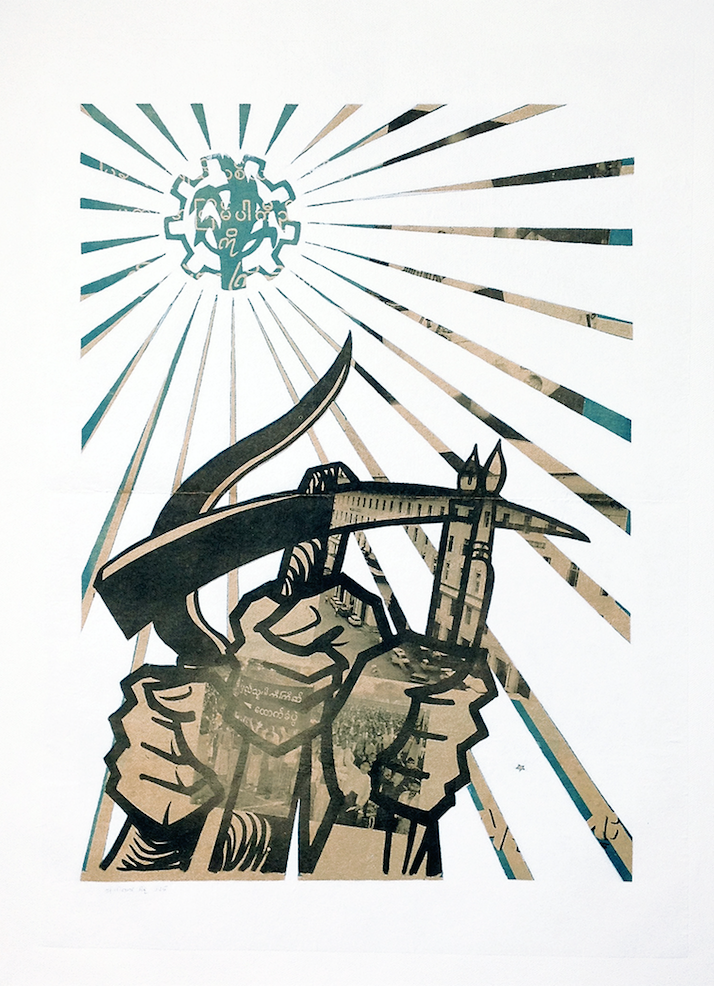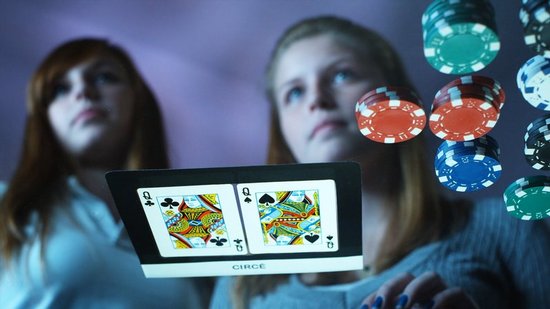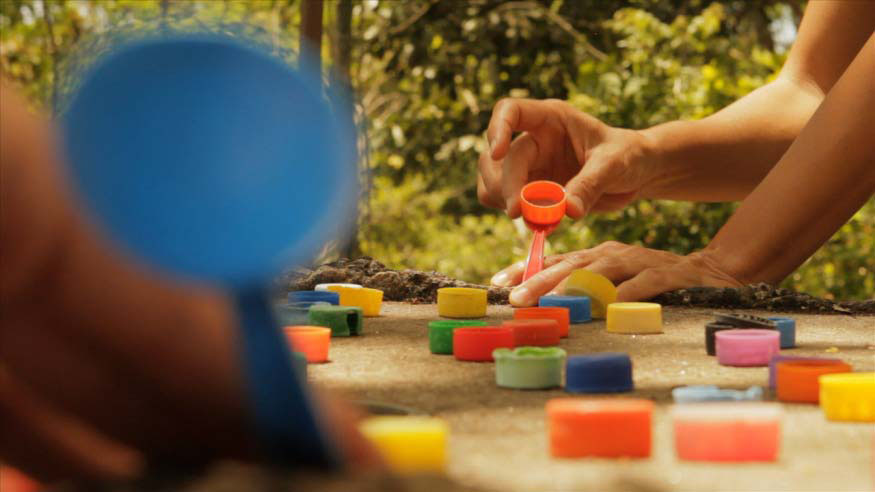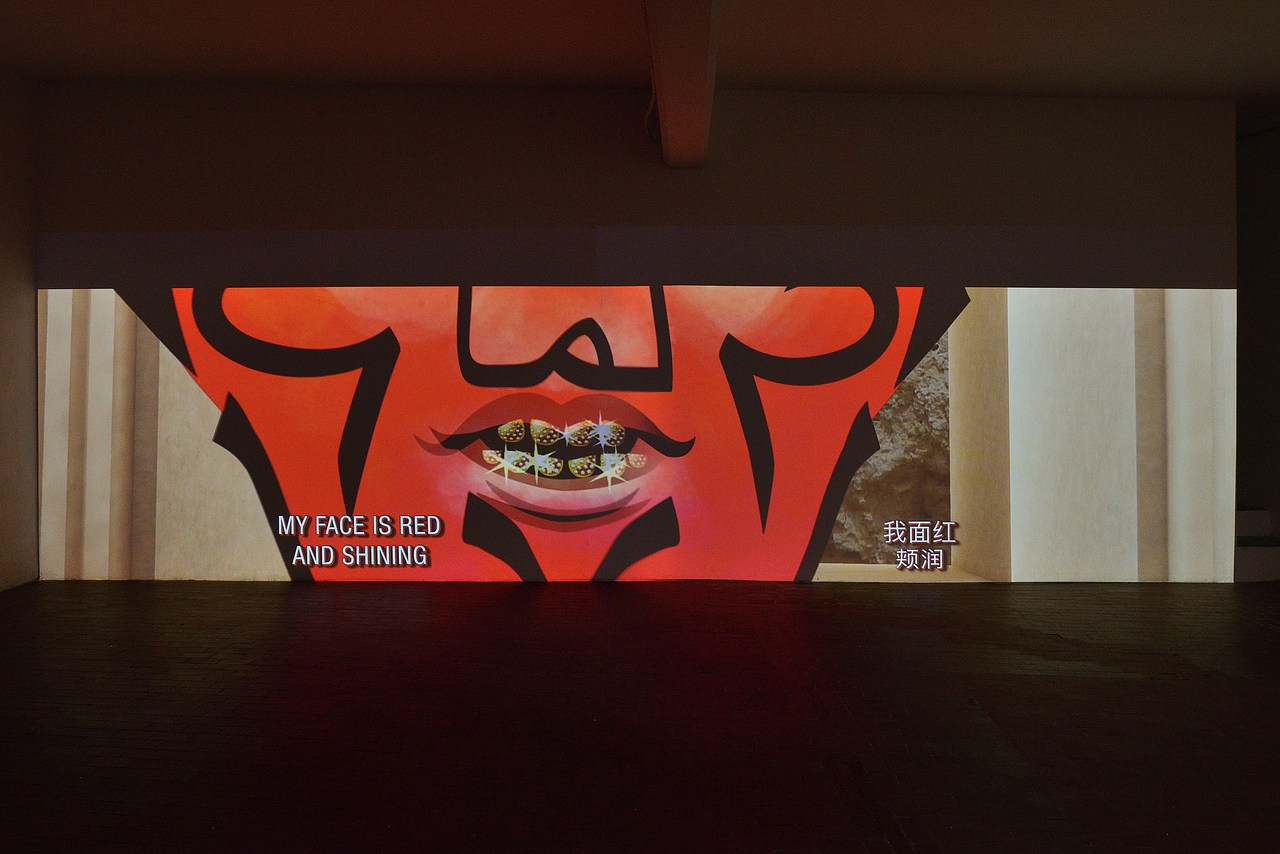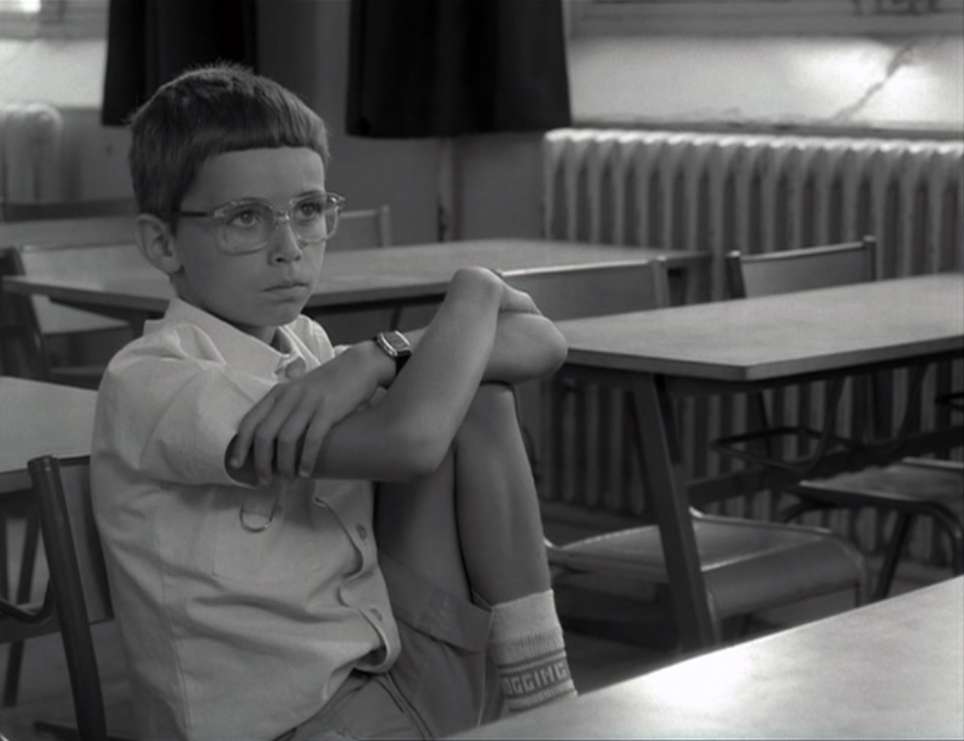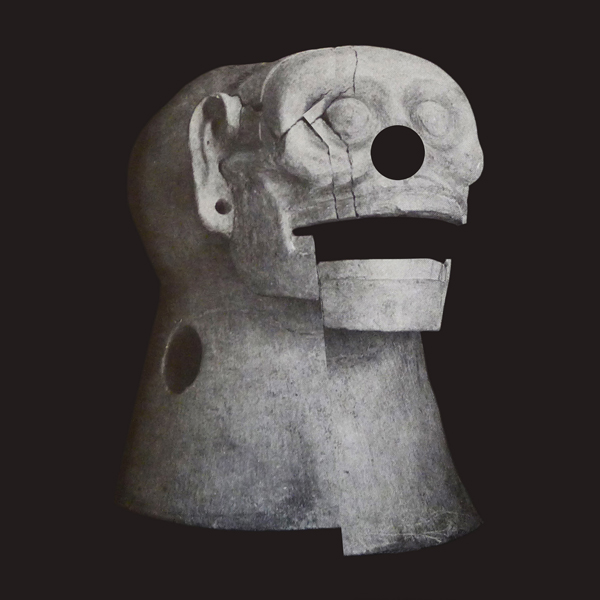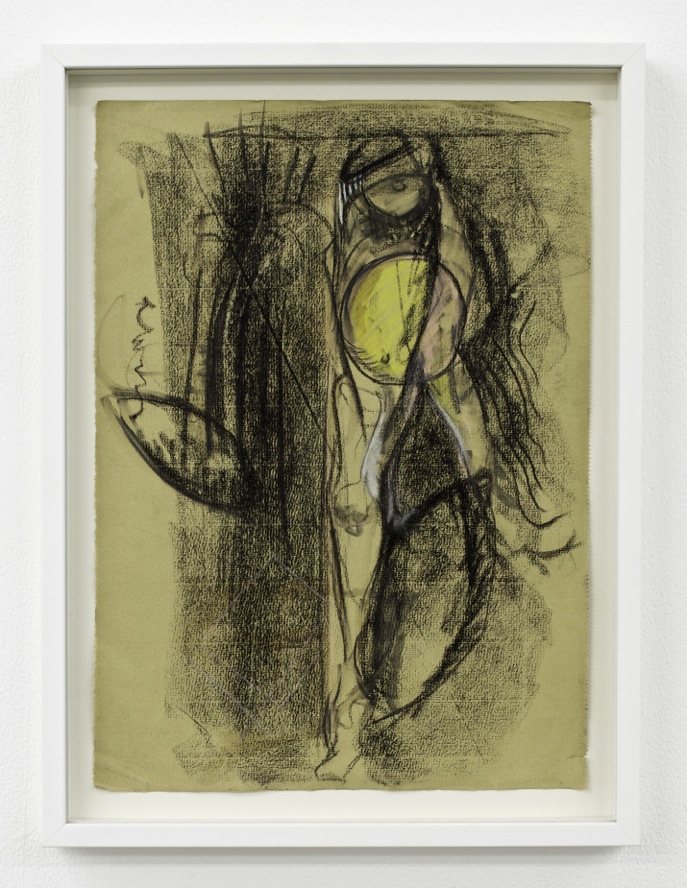
© » KADIST
Mary Ann Aitken
Untitled (Boom Box, Double-Sided) by Mary Ann Aitken is representational painting of a boom box on an unconventionally long canvas painted on both sides, to mimic the scale and appearance of the actual appliance. Known for going against trends, Aitken often favored dimensions, such as the square, that were otherwise considered out of style in contemporary painting. In this double-sided painting, one side depicts the titular boombox set up—a boxy cassette player, flanked by a pair of stereo speakers in front of wood panelling.

© » KADIST
Mary Ann Aitken
Untitled (Diptych) by Mary Ann Aitken is a pair of paintings; one entirely abstract and the other a hybrid of representational and abstract elements. The left-side painting is a cacaphonous all over composition of brushstrokes layered in the artist’s signature primary colors. In the same color scheme, the right-side painting portrays a still life with an arrangement of flowers as its focal point, with marks and splatter spilling from the left-side composition into the right.

© » KADIST
Doug Aitken
The version of Frontier acquired by the Kadist Collection consists of a single-channel video, adapted from the monumental installation and performance that Aitken presented in Rome, by the Tiber River, in 2009. In this film, Aiken’s allusion to “the frontier” and iconic imagery like the cowboy suggest that the American West Coast as a cultural construction. These notions are reinforced by two key elements in the film: its protagonist, the iconic West Coast artist Ed Ruscha, and its reference to the cinematic and the experience of the movie theater.

© » KADIST
Kelly Sinnapah Mary
Notebook 10 , l ‘enfance de sanbras (The Childhood of Sanbras) series by Kelly Sinnapah Mary is a sequel to an earlier series by the artist titled Cahier d’un non retour au pays natal (2015). This earlier work considers the process of reconstructing an identity of the Indian workers who arrived in the Caribbean during the post-slavery period. The work addresses the conditions of recruitment of these Indian workers, the strategies of the recruiters, how they lured them onto ships to bring them back to the plantations.

© » KADIST
Mary Reid Kelley
Priapus Agonistes by Mary Reid Kelley and Patrick Kelley is the first work in The Minotaur Trilogy (2013-2015), a trio of videos that reimagine the Greek myth of the Minotaur. The monstrous result of Queen Pasiphae’s infatuation with a bull, the Minotaur lived in a huge maze known as the Labyrinth where he would devour sacrificial offerings of youths and maidens. Traditionally, the story centers on Theseus and his heroic (and successful) quest to conquer the Minotaur, subsequently freeing the people of Athens from their obligations.

© » KADIST
Mary Reid Kelley
In the video The Syphilis of Sisyphus (2011), Reid Kelley transported her heroine to the French demimonde. The film centers on a pregnant Parisian prostitute who exemplifies Baudelaire’s paean to the superiority of cosmetic over natural beauty. With sets that shift between Sisyphus’s boudoir and the streets of Paris, the work is an antic romp through Revolutionary and post Revolutionary France, with brief vignettes involving everyone from Diderot, Marie Antoinette, and Marat to Robespierre, Napoleon, and Haussmann.

© » KADIST
Kelly Sinnapah Mary
Notebook 10 , l ‘enfance de sanbras (The Childhood of Sanbras) series by Kelly Sinnapah Mary is a sequel to an earlier series by the artist titled Cahier d’un non retour au pays natal (2015). This earlier work considers the process of reconstructing an identity of the Indian workers who arrived in the Caribbean during the post-slavery period. The work addresses the conditions of recruitment of these Indian workers, the strategies of the recruiters, how they lured them onto ships to bring them back to the plantations.

© » KADIST
Kelly Sinnapah Mary
Notebook 10 , l ‘enfance de sanbras (The Childhood of Sanbras) series by Kelly Sinnapah Mary is a sequel to an earlier series by the artist titled Cahier d’un non retour au pays natal (2015). This earlier work considers the process of reconstructing an identity of the Indian workers who arrived in the Caribbean during the post-slavery period. The work addresses the conditions of recruitment of these Indian workers, the strategies of the recruiters, how they lured them onto ships to bring them back to the plantations.

© » KADIST
Kelly Sinnapah Mary
Notebook 10 , l ‘enfance de sanbras (The Childhood of Sanbras) series by Kelly Sinnapah Mary is a sequel to an earlier series by the artist titled Cahier d’un non retour au pays natal (2015). This earlier work considers the process of reconstructing an identity of the Indian workers who arrived in the Caribbean during the post-slavery period. The work addresses the conditions of recruitment of these Indian workers, the strategies of the recruiters, how they lured them onto ships to bring them back to the plantations.

© » KADIST
Mark Bradford
Drawing & Print (Drawing & Print)
This untitled work from 2012 is a print originally made as part of the Wattis Institute for Contemporary Art’s artist limited edition series. It’s contrasting dark and vibrant tones presage his later series of works, exhibited at L. A.’s Hammer Museum as Scorched Earth. These larger works share a map-like quality, looking like aerial views of some scarred urban landscape.

© » KADIST
Tessa Mars
In this untitled acrylic painting, Tessa Mars explores the long-lasting effects of colonialism on the Afro-Caribbean diaspora, particularly in terms of female vulnerability and resilience. Drawing on her interest in retelling stories of her native country, and confronting the past and the present, Mars portrays her cultural essence and heritage by imagining spiritual spaces that connect people and land across time. With a pictorial practice that highlights pastel colors, the divinisation of the figures on the canvas and the spiritual elements within the composition ultimately enhance the narrative of her Caribbean ancestry while conflating the distinctions between autobiographical and historical events.

© » KADIST
Kelly Sinnapah Mary
Notebook 10 , l ‘enfance de sanbras (The Childhood of Sanbras) series by Kelly Sinnapah Mary is a sequel to an earlier series by the artist titled Cahier d’un non retour au pays natal (2015). This earlier work considers the process of reconstructing an identity of the Indian workers who arrived in the Caribbean during the post-slavery period. The work addresses the conditions of recruitment of these Indian workers, the strategies of the recruiters, how they lured them onto ships to bring them back to the plantations.

© » KADIST
Mary Helena Clark
By testing the limits of identification with the camera’s point of view, Delphi Falls cycles through multiple subjectivities. The film misuses more traditional narrative conventions -the suggestion of a story, the anchoring of actors as characters- to have the viewer constantly questioning who or what they are, and where they are located in the film’s world. Delphi Falls was included in the 2017 Whitney Biennial film program.

© » KADIST
Mary Reid Kelley
Situated in German-occupied Belgium at the end of World War I, Y ou Make Me Iliad by Mary Reid Kelley focuses on the story of two. characters: a Belgian prostitute working near the frontlines and a young German soldier charged with monitoring the brothels. Harboring literary aspirations, the soldier goes in search of material to complete his novel.

© » KADIST
Kelly Sinnapah Mary
Notebook 10 , l ‘enfance de sanbras (The Childhood of Sanbras) series by Kelly Sinnapah Mary is a sequel to an earlier series by the artist titled Cahier d’un non retour au pays natal (2015). This earlier work considers the process of reconstructing an identity of the Indian workers who arrived in the Caribbean during the post-slavery period. The work addresses the conditions of recruitment of these Indian workers, the strategies of the recruiters, how they lured them onto ships to bring them back to the plantations.

© » KADIST
Kelly Sinnapah Mary
Notebook 10 , l ‘enfance de sanbras (The Childhood of Sanbras) series by Kelly Sinnapah Mary is a sequel to an earlier series by the artist titled Cahier d’un non retour au pays natal (2015). This earlier work considers the process of reconstructing an identity of the Indian workers who arrived in the Caribbean during the post-slavery period. The work addresses the conditions of recruitment of these Indian workers, the strategies of the recruiters, how they lured them onto ships to bring them back to the plantations.
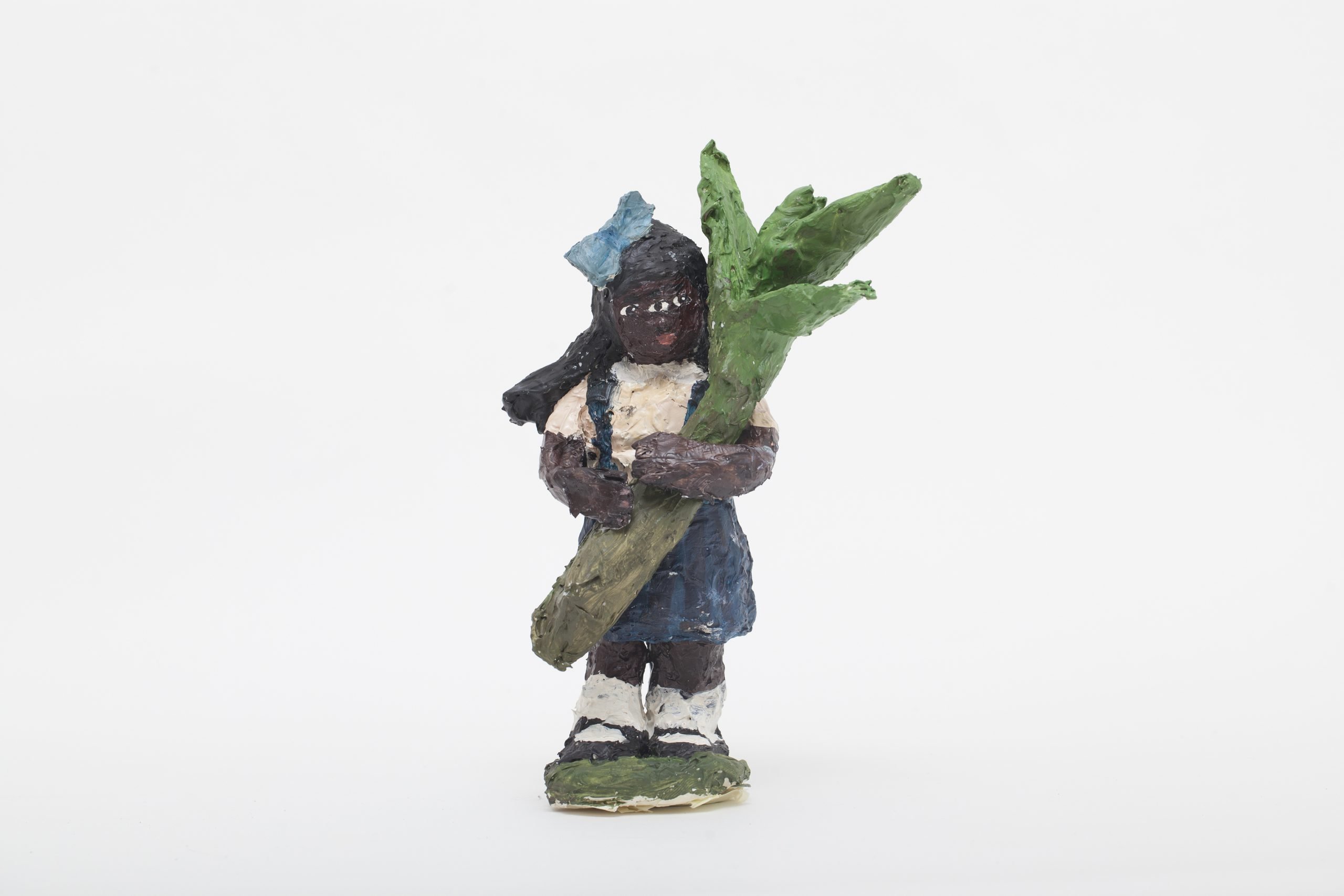
© » KADIST
Kelly Sinnapah Mary
Notebook 10 , l ‘enfance de sanbras (The Childhood of Sanbras) series by Kelly Sinnapah Mary is a sequel to an earlier series by the artist titled Cahier d’un non retour au pays natal (2015). This earlier work considers the process of reconstructing an identity of the Indian workers who arrived in the Caribbean during the post-slavery period. The work addresses the conditions of recruitment of these Indian workers, the strategies of the recruiters, how they lured them onto ships to bring them back to the plantations.

© » KADIST
Mary Reid Kelley
Kelley’s 2015 portrait of the poet Charles Baudelaire is one of a series of poets, rappers, and other thinkers who have influenced the artist’s ideas about beauty, creativity, and expression. As a challenging artist who marches to her own drum, Mary Reid Kelley is in the vanguard of a generation that blends the digital and the analog to dialogue with history. From 2009 to the present, she has made videos that fuse live performance, animation, drawing, sculpture, and digital design.

© » KADIST
Mary Helena Clark
The Dragon is the Frame by Mary Helena Clark is an elegy that is somewhat paradoxically organized as a film noir or murder mystery, one that pays direct homage to Hitchcock’s Vertigo . But the parts don’t fit, and it is only in the eventual recognition of this faux raccord that Clark’s higher purpose becomes apparent. As we hear Bernard Herrmann’s score, we see the Golden Gate Bridge, Mission Dolores, and other Vertigo locations in the present day.

© » KADIST
Kelly Sinnapah Mary
Notebook 10 , l ‘enfance de sanbras (The Childhood of Sanbras) series by Kelly Sinnapah Mary is a sequel to an earlier series by the artist titled Cahier d’un non retour au pays natal (2015). This earlier work considers the process of reconstructing an identity of the Indian workers who arrived in the Caribbean during the post-slavery period. The work addresses the conditions of recruitment of these Indian workers, the strategies of the recruiters, how they lured them onto ships to bring them back to the plantations.

© » KADIST
Kelly Sinnapah Mary
Notebook 10 , l ‘enfance de sanbras (The Childhood of Sanbras) series by Kelly Sinnapah Mary is a sequel to an earlier series by the artist titled Cahier d’un non retour au pays natal (2015). This earlier work considers the process of reconstructing an identity of the Indian workers who arrived in the Caribbean during the post-slavery period. The work addresses the conditions of recruitment of these Indian workers, the strategies of the recruiters, how they lured them onto ships to bring them back to the plantations.
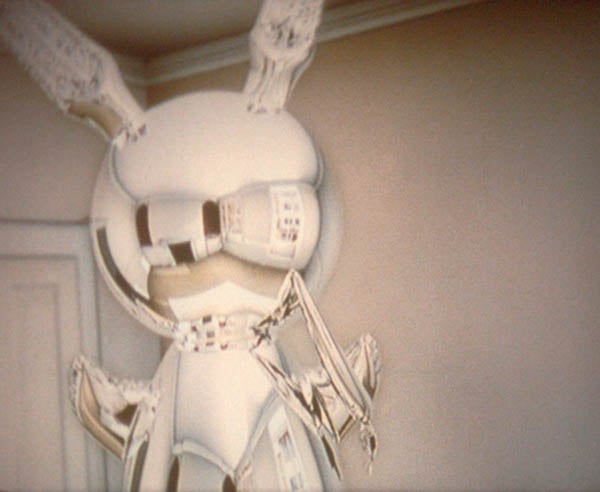
© » KADIST
Mark Leckey
In Made In Heaven , we are face to face with a sculptural apparition, a divine visitation in the artist’s studio. It isn’t just any object, but an iconic sculpture of the end of the 20th century: Jeff Koons’ Bunny. One key question in this work is of course the construction of images, but there is also the question of sculpture, of the passage from two-dimensionality to three-dimensionality.

© » KADIST
Marc Nagtzaam
Drawing & Print (Drawing & Print)
Nagtzaam’s medium is drawing and his repertory of forms varies from abstract hard-edge and wall drawing to the reproduction of written material that he collects from art magazines. The artist uses abstract architectural elements that he reproduces on the wall in which he inserts drawings, elements from photographs and drawings of texts collected from art magazines. The repetition, control and imperfection of the movements create a tension, a particular vibration in his geometrical drawings and in the drawings of texts.
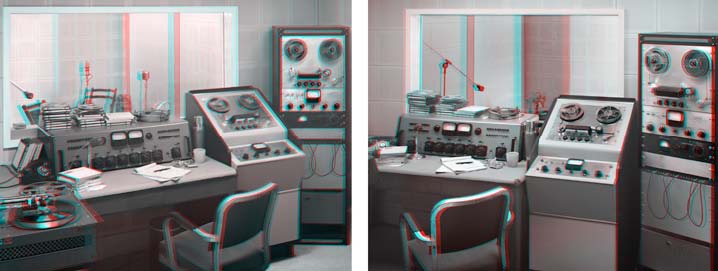
© » KADIST
Mark Soo
The two large-scale stereoscopic photographs in That’s That’s Alright Alright Mama Mama depict a recreation of Elvis Presley’s recording studio in Memphis, Tennessee. This study in doubles is underscored by its title, which repeats and doubles Elvis’s original song title. The images are hung in a specially angled wall and the viewers are provided special 3-D glasses in order to contemplate the image.

© » KADIST
Mark Grotjahn
Drawing & Print (Drawing & Print)
This particular drawing, like many of Grotjahn’s works, presents a decentered single-point perspective. Unlike the traditional vanishing point, the rays here emanate from the surface’s middle and hover around an indefinite and impossible convergence. The resulting fluttering of the image’s sections animates the drawing in relationship to its named subject, the butterfly.

© » KADIST
Jordan Ann Craig
Something To Do With Being Held by Jordan Ann Craig is inspired by a Cheyenne bead bag. Intrigued by the two shades of blue used for the source object (a deep dusty blue and a bold vivid cobalt blue) the artist replicated these shades in her painting. Craig then added in her own colors, including the pink-orange hues, to achieve a bold but soft quality about the work, as she states that she intended the work to convey vulnerability.

© » KADIST
Gary-Ross Pastrana
Gary-Ross Pastrana’s video installation Rewilding consists of three large-scale projections placed across the exhibition space. The poetic footage filmed by the artist portrays three interconnected worlds: a colony of termites; a piano repair workshop in the outskirts of Manila; and an empty concert theatre. Their interconnectivity is shaped by the voice-over of three narrators: a musician discussing the balance between order and chaos found in classical music; a piano repairman describing termite infestations in an instrument of European origin; and a scientist describing the unique social structures of this tropical parasite.

© » KADIST
Ana Vaz
Ana Vaz describes her film É Noite na América (It is Night in America) as an eco-terror tale, freely inspired by A cosmopolitics of animals by Brazilian philosopher Juliana Fausto; in which she investigates the political life of non-human beings and questions the modern idea of the exceptionality of the human species. In parallel to the feature film version, Vaz created a three-channel installation format meant to be displayed in contemporary art spaces. This edition includes three complementary video works that expand on the conceptual frameworks of the film.

© » KADIST
Ana Navas
Ana Navas uses humor to address formal, aesthetic, and societal conventions that are interwoven in the everyday through the normalization of gendered behaviors and style choices used to project personal and collective signifiers. In her Donation Vases she uses quotes taken from corporate coach Lois P. Frankel’s book Nice girls (still) don’t get the corner office: Unconscious Mistakes Women Make That Sabotage Their Careers (2004). The aspirational, somewhat cynical tone of the sentences – “When given a choice, sit next to most powerful person, their power will cascade over you,” “Why is it that women buy those little chains to hang reading glasses around their necks,” “If you see your reflection on a glossy surface & notice something wrong, avoid fixing it there” – reveals a particular understanding of what a professional, ambitious cis woman should look like, the persona she should project, and the type of desirable behaviors that constitute a stereotypical “successful woman” according to a capitalist morality.
Kelly Sinnapah Mary
Kelly Sinnapah Mary is a multidisciplinary artist who’s work is informed by the diasporic journey of her ancestors...
Mary Reid Kelley
Drawing from literature, plays, and historical events, Mary Reid Kelley makes rambunctious videos that explore the condition of women throughout history...
Chantal Edie and Zacharie Ngnogue
Chantal Edie and Zacharie Ngnogue are a photography duo who channel their personal experiences into social commentaries...
Yee I-Lann
- location: Kuala Lumpur, Malaysia
- year born: 1971
- gender: female
- nationality: Malaysian
- home town: Sabah, Malaysia
Ana Vaz
Ana Vaz is an artist and filmmaker whose works speculate on the relationships between self and other, and myth and history, through a cosmology of signs, references, and perspectives...
Mary Ann Aitken
Mary Ann Aitken was known to be very private about her art practice; she was considered somewhat of an outsider by her peers affiliated with the second wave of Detroit’s Cass Corridor arts movement...
John Wood and Paul Harrison
John Wood and Paul Harrison have been working collaboratively since 1993, producing single screen and installation-based video works...
Leung Chi Wo and Wong Sara
Leung Chi Wo tends to highlight in his art the boundaries between viewing and voyeurism, real and fictional, and art and the everyday...
An-My LE
- location: New York, New York
- year born: 1960
- gender: female
- home town: Saigon, Vietnam
Mary Helena Clark
Mary Helena Clark is an artist working in film, video, and installation...
Mark Grotjahn
- location: Los Angeles, California
- year born: 1968
- gender: male
- nationality: American
- home town: Pasadena, California
Nan Goldin
- year born: 1953
- gender: female
- nationality: American
- home town: Washington, D.C.
Slavs and Tatars
Self-described as an “Eurasian-based” collective, Slavs and Tatars investigates the “polemics and intimacies” of the region “east of the former Berlin Wall and west of the Great Wall of China” or Caucasia...
Ho Rui An
The artist, writer, and researcher Ho Rui An probes histories of globalization and governance, performing a detournement of dominant semiotic systems across text, film, installation, and lecture...
John Lucas and Claudia Rankine
John Lucas and Claudia Rankine are interdisciplinary thinkers and makers committed to exploring the nuances of race and power in our daily lives...
Gabriella and Silvana Mangano
Gabriella Mangano and Silvana Mangano are an artistic duo and identical twins known for their collaborative and performative video practice...
Tun Win Aung and Wah Nu
Wah Nu and Tun Win Aung, respectively born in 1977 and 1975, Yangon, Myanmar...
Lenka Clayton and Phillip Andrew Lewis
Lenka Clayton and Phillip Andrew Lewis’s collaborative practice is social at its core: it engages with and connects communities outside of the so-called art world in both production and presentation...
Mark Soo
Born in Singapore, raised in Malaysia, and based in Canada, artist and curator Mark Soo’s practice is concept-driven and research-based...
Angela Detanico and Rafael Lain
Linguists, semiologists, and graphic designers by training, Angela Detanico and Raphaël Lain consider the use of graphic signs in society...
Christine Sun Kim and Thomas Mader
Christine Sun Kim and Thomas Mader have been collaborating for the last 5 years, covering communication in a variety of formats such as recording an overnight shipment from Berlin to New York ( Recording Contract , 2013), compiling 24 hours of invited contributors’ studio time ( Busy Day , 2014), and using the arm game, a combination of body and face, in order to describe a series awkward situations ( Classified Digits , 2016)....
Anne Samat
An exuberant and precise sculptor, Anne Samat blends the aesthetic of international queer cultures – which she proudly represents as a transgender activist – with various textile and bricolage influences from South East Asia and beyond...
Ana Navas
Ana Navas’s practice deals with the vulgarization of modern art, understanding the term vulgar in its original sense of being appropriated by common people...
Mark Bradford
- location: Los Angeles, California
- year born: 1961
- gender: male
- nationality: American
- home town: Los Angeles, California
Musquiqui Chihying and Gregor Kasper
Through his artistic career, Musquiqui Chihying has striven to dislocate and reconstruct established modes of behavior within systems and structures of power...
Olive Martin and Patrick Bernier
Patrick Bernier and Olive Martin are a duo of artists collaborating since 1999...
Doug Aitken
- year born: 1968
- gender: male
- nationality: American
- home town: Redondo Beach, California
Nathan Mabry
- location: Los Angeles, California
- year born: 1978
- gender: male
- nationality: American
- home town: Durango, Colorado
Donna Conlon and Jonathan Harker
- location: Panama City, Panama
- year born: 1966
- nationality: American and Ecuadorian

© » APERTURE
about 5 months ago (12/01/2023)
For the past two decades, An-My Lê has used photography to examine her personal history and the legacies of US military power, probing the tension between experience and storytelling....

© » LARRY'S LIST
about 14 months ago (03/01/2023)
CIRCA collaborates with Anne Imhof to present #YOUTH24 - a 24-hour print fundraiser...
-
1980-1989
Jean-Marie Straub and Danièle Huillet
1982En rachâchant is based on the short story Ah! Ernesto! (1971) by Marguerite Duras in which the child Ernesto does not want to go to school anymore as all that he is taught are things he does not know...
-
1990-1999
John Wood and Paul Harrison
1996One of John Wood and Paul Harrison’s earliest works, Device features Harrison performing a series of actions, assisted by the titular ‘devices’, that use physics to force his body into unusual and uncomfortable positions...
John Wood and Paul Harrison
19973-Legged is an early video work by John Wood and Paul Harrison in which they appear with their legs tied together (as one would do in a three-legged race)...
-
2000-2009
Mary Ann Aitken
2002Untitled (Boom Box, Double-Sided) by Mary Ann Aitken is representational painting of a boom box on an unconventionally long canvas painted on both sides, to mimic the scale and appearance of the actual appliance...
Mark Grotjahn
Drawing & Print
2002(Drawing & Print) This particular drawing, like many of Grotjahn’s works, presents a decentered single-point perspective...
Maayan Amir and Ruti Sela
2003In Beyond Guilt the two artists create a portrait of our generation in three parts...
Mark Leckey
2004In Made In Heaven , we are face to face with a sculptural apparition, a divine visitation in the artist’s studio...
Mary Ann Aitken
2009Untitled (Diptych) by Mary Ann Aitken is a pair of paintings; one entirely abstract and the other a hybrid of representational and abstract elements...
Doug Aitken
2009The version of Frontier acquired by the Kadist Collection consists of a single-channel video, adapted from the monumental installation and performance that Aitken presented in Rome, by the Tiber River, in 2009...
Pauline Boudry and Renate Lorenz
2009Salomania sees choreographer and filmmaker Yvonne Rainer and artist Wu Tsang rehearse scenes from Valda’s Solo , a chapter of a film Rainer made in 1972 after having seen women perform the dance of the seven veils in Alla Nazimova’s 1923 silent film Salomé ...
Jay Chung and Takeki Maeda
2009Jay Chung and Q Takeki Maeda remake a clip from the 1970s they found on the internet, and without really changing this archive material, displace it by imitating the staging and the acting with scrupulous precision...
-
2010-2019
Mary Reid Kelley
2010Situated in German-occupied Belgium at the end of World War I, Y ou Make Me Iliad by Mary Reid Kelley focuses on the story of two...
Olive Martin and Patrick Bernier
2010The Mohawk, the emblematic Frontier river in the period of American colonisation, is here a cable of data transmission, and the 7 Sultans Casino is a virtual destination, one of the three hundred online casinos hosted by the servers located in Kahnawake, a small native american indian reserve to the south of Montreal...
The Propeller Group and Superflex
2010Fade In (the whole title of the film is actually the entire five page script) is a collaboration with the Danish artist collective Superflex (group of freelance artist–designer–activists committed to social and economic change, founded in 1993 by Jakob Fenger, Rasmus Nielsen and Bjørnstjerne Christiansen)...
Leung Chi Wo and Wong Sara
2010Office Lady with a Red Umbrella restages a figure from a 1980 postcard made from a photograph from 1950’s...
An-My LE
2010The print Patient Admission, US Naval Hospital Ship Mercy, Vietnam (2010) features an Asian Buddhist monk and an American Navy Solider on board the Mercy ship –one of the two dedicated hospital ships of the United States Navy– sitting upright in their chairs and adopting the same posture...
Võ An Khánh
2010In Extra Curriculum Political Science Class 7/1972 , a group of women walk bare-foot and single file towards Dat Mui Mangrove in Ca Mau Province to attend ‘political science class’...
Jane Jin Kaisen and Guston Sondin-Kung
2010The Woman, The Orphan, and The Tiger begins with the sound of women’s voices describing histories of violence, of things repressed and silenced...
Leung Chi Wo and Wong Sara
2010Photojournalist with Two Cameras restages a portrait of a photojournalist from the background of an old photograph of protest published in South China Morning Post on January 10, 2010 under the headline “Return of the Radicals: Recent angry protests are nothing new.” The photojournalist in the photograph, probably from a protest of earlier decades, was capturing the scene of a protester’s arrest while wearing two cameras...
Mary Reid Kelley
2011In the video The Syphilis of Sisyphus (2011), Reid Kelley transported her heroine to the French demimonde...
Ana Teresa Fernández
Drawing & Print
2011(Drawing & Print) The artist writes about her work Borrando la Frontera, a performance done at Tijuana/San Diego border: “I visually erased the train rails that serve as a divider between the US and Mexico...
Ei Arakawa and Sergei Tcherepnin
2011Part of a series entitled “Looking at Listening”, 2011, the piece invited the spectator to experiment and consider sound as a kinetic and synesthetic process, where multiple experiences and senses can cross...
Tun Win Aung and Wah Nu
2011Tun Win Aung and Wah Nu initiated the series 1000 Pieces (of White) in 2009, as a way to produce objects and images as a portrait of their shared life as partners and collaborators...
Mark Bradford
Drawing & Print
2012(Drawing & Print) This untitled work from 2012 is a print originally made as part of the Wattis Institute for Contemporary Art’s artist limited edition series...
Ana Roldán
2012Ana Roldán’s Primeval forms series looks up close at the fecund shapes of plants often found in the artist’s native Mexico...
Ana Roldán
2012Ana Roldán’s Displacements works use images taken from a 1970s exhibition catalogue for an exhibition called The Death in Mexico...
Donna Conlon and Jonathan Harker
2012In Tapitapultas (2012), Donna Conlon and Jonathan Harker comment on mass consumerism and pollution by way of a game they invented...
Mary Reid Kelley
2013Priapus Agonistes by Mary Reid Kelley and Patrick Kelley is the first work in The Minotaur Trilogy (2013-2015), a trio of videos that reimagine the Greek myth of the Minotaur...
Anne Imhof
Drawing & Print
2013(Drawing & Print) “School of the seven Bells (SOTSB)” is based on a series of hands games in which an object is passed from hand to hand...
Anna-Bella Papp
2013Untitled exemplifies the format that Anna Bella-Papp most commonly works in, using her hands to create delicate tablet-like reliefs within a rectangular form made out of clay...
Yee I-Lann
2013Sarcastically titled to call attention to the problematic notions underlying colonialism, this photograph shows hundreds of Native Malaysians seated quietly behind one of their colonial oppressors...
Mary Helena Clark
2014The Dragon is the Frame by Mary Helena Clark is an elegy that is somewhat paradoxically organized as a film noir or murder mystery, one that pays direct homage to Hitchcock’s Vertigo ...
Marc Nagtzaam
Drawing & Print
2014(Drawing & Print) Nagtzaam’s medium is drawing and his repertory of forms varies from abstract hard-edge and wall drawing to the reproduction of written material that he collects from art magazines...
Anna Boghiguian
2014In the painting called “The Consciousness of Memory, Time, and Guilt” as in many of her recent works, the body is fragmented...
Mary Reid Kelley
2015Kelley’s 2015 portrait of the poet Charles Baudelaire is one of a series of poets, rappers, and other thinkers who have influenced the artist’s ideas about beauty, creativity, and expression...
Gabriella and Silvana Mangano
2015There is no there by Gabriella and Silvana Mangano is a black and white looped video with sound, in conjunction with a live performance...
João Maria Gusmão and Pedro Paiva
2015The artist duo João Maria Gusmão and Pedro Paiva traveled to Japan for a month to make a series of short 16mm films, often shot in slow-motion...
Christine Sun Kim and Thomas Mader
2016Indexes that either allow or inhibit the establishment of communication exist in both signed as well as spoken languages...
Mary Helena Clark
2017By testing the limits of identification with the camera’s point of view, Delphi Falls cycles through multiple subjectivities...
Etel Adnan and Lynn Marie Kirby
Drawing & Print
2017(Drawing & Print) In conjunction with KADIST’s 2017 exhibition If Not Apollo, the Breeze , artist and filmmaker Lynn Marie Kirby performed Transmissions , a video and live reading created with longtime collaborator Etel Adnan...
Gary-Ross Pastrana
2018Gary-Ross Pastrana’s video installation Rewilding consists of three large-scale projections placed across the exhibition space...
Anne Samat
2018Anne Samat’s Puteri 3 references Ulek Mayang, a classical Malay dance, performed in a ritualistic pre-Islamic context...
John Lucas and Claudia Rankine
Drawing & Print
2018(Drawing & Print) Historically, blondeness has been a signifier for desirability and beauty, speaking to “purity” — the purity of whiteness — like no other bodily attribute except, perhaps, blue eyes...
Pooja Gurung and Bibhusan Basnet
2018DADYAA: The Woodpeckers of Rotha by Pooja Gurung and Bibhusan Basnet illuminates a unique and seldom seen international perspective on indigenous cultures and contemporary social issues in the Nepali context...
Jordan Ann Craig
2019Something To Do With Being Held by Jordan Ann Craig is inspired by a Cheyenne bead bag...
Ana María Millán
2019Interested in role-play and videogames, Ana María Millán developed workshops with different communities in order to create characters and scenarios for her animations, often in collaboration with a choreographer...
Musquiqui Chihying and Gregor Kasper
2019Addressing the legacy of colonialism, The Guestbook by Musquiqui Chihying and Gregor Kasper is a slow-paced, black-and-white film exploring the German colony of Togoland, now the Republic of Togo...
-
2020-2029
Yee I-Lann
20207-headed Lalandau Hat by Yee I-Lann is an intricately woven sculpture evoking the ceremonial headdress worn by Murut men in Borneo...
Chantal Edie and Zacharie Ngnogue
2020Au non de la liberté (Tiko drink Kumba drunk) is a photographic series by Zacharie Ngnogue and Chantal Edie that considers the correlation between those who hold power in Cameroon and how their actions affect the populations they rule in often compromising ways...
Chantal Edie and Zacharie Ngnogue
2020Au non de la liberté (Tiko drink Kumba drunk) is a photographic series by Zacharie Ngnogue and Chantal Edie that considers the correlation between those who hold power in Cameroon and how their actions affect the populations they rule in often compromising ways...
Chantal Edie and Zacharie Ngnogue
2020Au non de la liberté (Tiko drink Kumba drunk) is a photographic series by Zacharie Ngnogue and Chantal Edie that considers the correlation between those who hold power in Cameroon and how their actions affect the populations they rule in often compromising ways...
Kelly Sinnapah Mary
2021Notebook 10 , l ‘enfance de sanbras (The Childhood of Sanbras) series by Kelly Sinnapah Mary is a sequel to an earlier series by the artist titled Cahier d’un non retour au pays natal (2015)...
Kelly Sinnapah Mary
2021Notebook 10 , l ‘enfance de sanbras (The Childhood of Sanbras) series by Kelly Sinnapah Mary is a sequel to an earlier series by the artist titled Cahier d’un non retour au pays natal (2015)...
Kelly Sinnapah Mary
2021Notebook 10 , l ‘enfance de sanbras (The Childhood of Sanbras) series by Kelly Sinnapah Mary is a sequel to an earlier series by the artist titled Cahier d’un non retour au pays natal (2015)...
Kelly Sinnapah Mary
2021Notebook 10 , l ‘enfance de sanbras (The Childhood of Sanbras) series by Kelly Sinnapah Mary is a sequel to an earlier series by the artist titled Cahier d’un non retour au pays natal (2015)...
Kelly Sinnapah Mary
2021Notebook 10 , l ‘enfance de sanbras (The Childhood of Sanbras) series by Kelly Sinnapah Mary is a sequel to an earlier series by the artist titled Cahier d’un non retour au pays natal (2015)...
Kelly Sinnapah Mary
2021Notebook 10 , l ‘enfance de sanbras (The Childhood of Sanbras) series by Kelly Sinnapah Mary is a sequel to an earlier series by the artist titled Cahier d’un non retour au pays natal (2015)...
Kelly Sinnapah Mary
2021Notebook 10 , l ‘enfance de sanbras (The Childhood of Sanbras) series by Kelly Sinnapah Mary is a sequel to an earlier series by the artist titled Cahier d’un non retour au pays natal (2015)...
Kelly Sinnapah Mary
2021Notebook 10 , l ‘enfance de sanbras (The Childhood of Sanbras) series by Kelly Sinnapah Mary is a sequel to an earlier series by the artist titled Cahier d’un non retour au pays natal (2015)...
Kelly Sinnapah Mary
2021Notebook 10 , l ‘enfance de sanbras (The Childhood of Sanbras) series by Kelly Sinnapah Mary is a sequel to an earlier series by the artist titled Cahier d’un non retour au pays natal (2015)...
Kelly Sinnapah Mary
2021Notebook 10 , l ‘enfance de sanbras (The Childhood of Sanbras) series by Kelly Sinnapah Mary is a sequel to an earlier series by the artist titled Cahier d’un non retour au pays natal (2015)...
Anne Imhof
2021Anne Imhof’s video work Untitled (Wave) creates resonances between the feminine, adoration, and immateriality, while also referring to the history of art and aesthetics, in particular the concept of the sublime...
Jonas Van and Juno B
2021Jonas Van and Juno B’s video work Kebranto is anchored by the figure of Boitatá, a snake that is part of the imaginary Guaraní communities that live between the current nation-states of Argentina, Brazil, Paraguay, and Uruguay...
Tessa Mars
2022In this untitled acrylic painting, Tessa Mars explores the long-lasting effects of colonialism on the Afro-Caribbean diaspora, particularly in terms of female vulnerability and resilience...
Ana Vaz
2022Ana Vaz describes her film É Noite na América (It is Night in America) as an eco-terror tale, freely inspired by A cosmopolitics of animals by Brazilian philosopher Juliana Fausto; in which she investigates the political life of non-human beings and questions the modern idea of the exceptionality of the human species...
Michelle and Noel Keserwany
2022Les Chenilles by Michelle and Noël Keserwany is a sensual film that translates the source of women’s oppression into the means for their liberation...
Miguel and Natalia Fernández de Castro and Mendoza
2022The Absolute Restoration of All Things is a collaboration by artist Miguel Fernández de Castro and anthropologist Natalia Mendoza...
Köken Ergun and Satyam Mishra
2022Nepal and China signed an agreement for the Belt and Road Initiative (BRI) in 2017...
Köken Ergun and Tashi Lama
2022Nepal and China signed an agreement for the Belt and Road Initiative (BRI) in 2017...
Köken Ergun and Satyam Mishra
2022Nepal and China signed an agreement for the Belt and Road Initiative (BRI) in 2017...
Lenka Clayton and Phillip Andrew Lewis
2022Five Hundred Twenty-Four, a single-channel video installation by Lenka Clayton and Phillip Andrew Lewis, features singers from over twenty Cleveland-area choirs counting numbers in an iterative process: one person sings “one”, then two people sing “two”, and so forth, to 524...













